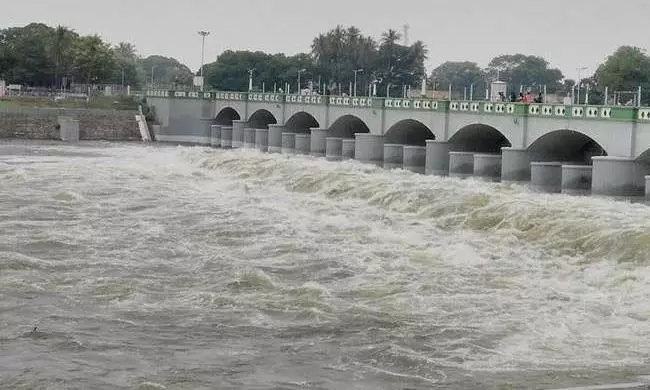With summer looming in the horizon, Bengaluru city seems to be already in the throes of a water shortage.
On February 27, the Bangalore Water Supply and Sewerage Board (BWSSB) announced a 24-hour shutdown of water supply from 6 am on February 27 onwards till 6 am on February 28. The reason given by India's IT capital’s water board is that it has to conduct essential maintenance work and install Unaccounted For Water (UFW) bulk flow meters.
This has brought the problem of the threat of a water crisis in Bengaluru, to the fore again. The Federal throws light on the impending threat of a water crisis in Bengaluru:
Where does Bengaluru get its water from?
Most parts get Cauvery water through BWSSB connections, while other areas that don't have a Cauvery water connection get water from their borewells and water tankers. The high-end apartments in east Bengaluru depend entirely on these borewells and water tankers.
Why is Bengaluru grappling with water supply issues?
There are multiple reasons but the issue of water supply is largely due to the fact that Bengaluru city has witnessed unchecked growth and development. This development has cost Bengaluru dearly as it has lost 79 percent of water bodies and 88 per ent of green cover over the last four decades, according to studies at the Indian Institute of Science (IISc), reported Reuters.
Moreover, though the city presently gets about 1,850 million litre per day (MLD), it requires at least 1,680 MLD more to meet water needs, said media reports.
The burgeoning population is also a major factor, putting stress on the city's water resources. The city has around 1 crore residents, and this number is increasing by 10 lakh every year. By 2025, the number is expected to rise to 1.25 crore.
According to experts, the lack of rainfall has also caused water in the Cauvery basin to be reduced. It has also led to low water levels in the city's reservoirs, adding more pressure on other sources like the Cauvery water. Besides serving the city's needs, Cauvery water also serves the irrigation needs of farmers.
Bengaluru’s groundwater resources too have depleted, and at least 1,240 out of 10,995 borewells are now at risk of drying up.
Which areas in Bengaluru suffer the most from a water crisis?
Outer city areas like Mahadevapura, Whitefield and Varthur, which have many high-rise apartments and posh communities, are largely affected by the water crisis. The water crisis is acute here for many months as these areas don’t get Cauvery water and are dependent on the dwindling groundwater resources. These apartments then have to wait for water tankers, which have become hard to come by and prices have also shot up considerably in the last month.
What’s worsening the situation?
Some tanker businesses are trying to illegally drill more borewells, and this had led to a special task force being set up to check the menace in areas like Mahadevapura.
Of the 11,000 government-owned borewells in the city, 800 have been completely out of service and even in those functional, water levels are receding. There is talk of rejuvenating these borewells, but not much has been done so far. Karnataka deputy chief minister DK Shivakumar revealed plans to address the crisis, including allocating ₹8 crore for additional borewells.
Skyrocketing water tanker prices
The price of water tankers in the city has shot up sky high as well, with rates likely to go up even further during summer. In some parts of Bengaluru, residents are having to pay as much as ₹2,000 for a 12,000-litre tanker, which earlier used to cost ₹1,200.
An estimated 20 percent of Bangaloreans depend on private tanker operators for drinking water. The Karnataka government has promised to fix the rates for tankers.
What BWSSB is doing?
The BWSSB is all set to launch a ‘Save Water’ campaign in two weeks. It has been organising awareness campaigns to educate Bengaluru residents on water conservation practices and raise awareness about reducing water consumption and using alternative sources of water.
The BWSSB is encouraging industries and commercial establishments to use treated water. They are also leasing out private borewells and renting additional tankers to bridge the water supply gap.
There is also a concerted effort to revive the existing borewells to increase water availability in the city, officials told the media.
What are the efforts made by the state government?
Besides earmarking Rs 200 crore in the budget to strengthen its drinking water infrastructure, the state government is expected to launch the Cauvery Phase-5 project in May, to address the water supply challenges faced by the city.
The project will provide 110 litre daily to Bengaluru and will involve the construction of 228 km of drainage pipelines and 13 Sewage Treatment Plants (STP). The plants will have the capacity to treat 100 million liters per day (MLD) of sewage water.
To ensure that the reservoirs in the Cauvery basin cater to the city's drinking water needs over other uses, the BWSSB has written two letters to Cauvery Neeravari Nigam Ltd. asking them to reserve 1.6 tmcft of water every month till March and 2.42 tmcft of water every month from April.
According to officials, if the government releases water to save the standing crops like it recently released the Krishna waters from reservoirs to save the chilli crop, the water scarcity will take a turn for the worse.
Media reports also suggested that the BWSSB officials seemed confident of tiding over any crisis in the present condition. And they only foresee a major challenge for Bengaluru city, if the Cauvery Management Authority orders the release of Cauvery water for standing crops in Karnataka and Tamil Nadu in April and May.



